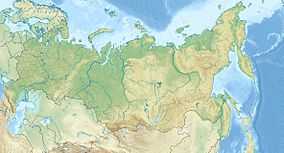Denisova Cave

Denisova Cave (Денисова пещера, also Ayu-Tash) is a cave in the Bashelaksky Range of the Altai mountains, Siberia, Russia. The cave is of great paleoarchaeological and paleontological interest. Bone fragments of the Denisova hominin, sometimes called the "X woman" (referring to the maternal descent of mitochondrial DNA) originate from the cave, including artifacts dated to ~40,000 BP. The cave is located in a region thought to have been inhabited concurrently in the past by Neanderthals and modern humans.
Description
Coordinates: 51°23′51.29″N 84°40′34.34″E / 51.3975806°N 84.6762056°E

Located in Altai Krai, at the border of the Altai Republic, the cave is near the village of Chorny Anui (Чёрный Ануй), and some 150 km south of Barnaul, the nearest major city.[1] The cave, which is approximately 28 m above the right bank of the Anuy River (a left tributary of the Ob), has formed in upper Silurian limestone and contains a floor area of about 270 metres2. It contains a central chamber with a floor of 9 x 11 metres with side galleries.[2] It has been described as both as a karst cave[1] and as a sandstone cave.[2]
Cave sediments are rich with remnants of animals, including extinct ones. Remains of 27 species of large and medium-sized mammals have been found, (such as cave hyena, cave lion, etc.) and 39 species of small mammals, as well as remnants of reptiles, 50 bird species and other vertebrates.[3][4] Pollen in the sediments of cave is used for palaeoclimatological research.
History
In the 18th century, the cave was inhabited by a hermit, Dionisij (Denis), and was named after him, while the indigenous Altay people call it Ayu-Tash (Bear Rock).[1] In the 1970s, Soviet scientists discovered paleoarcheological remains in the cave that led to further explorations.[1] So far, 22 strata have been identified, with archeological artifacts that cover the time from Dionisij back to about 125,000-180,000 years ago.[2] The dating of the strata was accomplished by the use of thermoluminescence dating of sediments, or, in some cases, radiocarbon dating on charcoal.[2] Among the archeological artifacts are Mousterian- and Levallois-style tools attributed to Neanderthals.[5] Beside tools, researchers found decorative objects of bone, mammoth tusk, animal teeth, ostrich egg shell, fragments of a stone bracelet made of drilled, worked and polished dark green chloritolite, and pendants.[2] The average annual temperature of the cave remains at 0 °C (32 °F), which has contributed to the preservation of archaic DNA among the remains discovered.[6]
Denisova hominin
Scientists from the Institute of Archaeology and Ethnology of Novosibirsk have investigated the cave. Among the artifacts which had been left about 30,000 to 48,000 years ago (strata 9-11), bones were identified. One of these bones was a piece of phalanx of a child that was analyzed by Svante Pääbo and coworkers from the Max Planck Institute for Evolutionary Anthropology in Leipzig; its mitochondrial DNA revealed a structure that differs from known human patterns and has been ascribed to "Denisova hominin", apparently an extinct hominin species or subspecies.[5] Further analysis revealed the Denisovans were related to the Neanderthals and interbred with the ancestors of modern Melanesians.[7]
References
- ↑ 1.0 1.1 1.2 1.3 "Денисова пещера. Denisova-Denisova Cave-Denis Cave". Retrieved March 24, 2010.
- ↑ 2.0 2.1 2.2 2.3 2.4 Hirst K K. "Denisova Cave (Siberia).Altai Mountain Paleolithic Site of Denisova Cave". Retrieved March 24, 2010.
- ↑ "Шуньков М. В, Агаджанян А. К. Палеография палеолита Денисовой пещеры. Археология, этнография и антропология Евразии. 2000.- No. 2 (2).- pages 2-20.". Retrieved March 28, 2010.
- ↑ "Denisova Cave – abode of Denisova hominins, Wondermondo". Retrieved March 28, 2010.
- ↑ 5.0 5.1 Rex Dalton (March 24, 2010). "Fossil finger points to new human species. DNA analysis reveals lost relative from 40,000 years ago.". Nature 464: 472–473. doi:10.1038/464472a. Retrieved March 24, 2010.
- ↑ Mitchell, Alanna, DNA Turning Human Story Into a Tell-All, New York Times, Science section, p. D1, January 30, 2012
- ↑ Carl Zimmer (22 December 2010). "Denisovans Were Neanderthals' Cousins, DNA Analysis Reveals". NYTimes.com. Retrieved 22 December 2010.